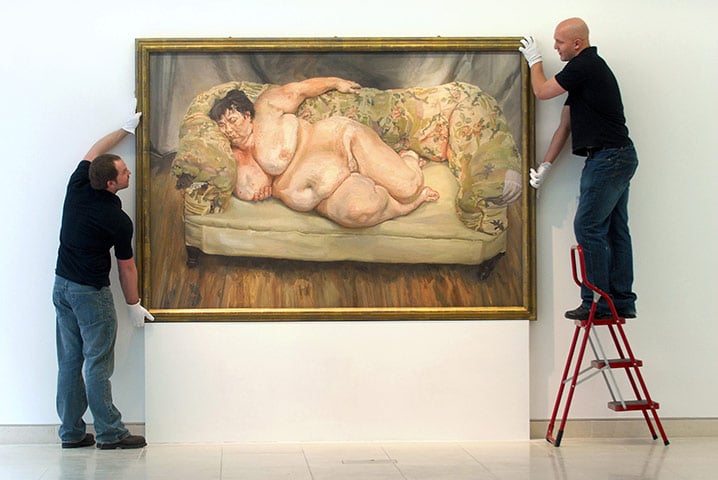
Benefits Supervisor Sleeping
My friend Christopher Benson has some thoughtful and provocative meditations on the above painting and others by the recently departed Lucian Freud. I was not familiar with his work, but Benson has me convinced that I should be:
Freud’s virtuosic details of the human form are widely admired, but his paintings raise questions about whether those details are loving or cruel. Perhaps it not a simple either/or. His “warts and all” approach is honest and refreshing if for no other reason than it serves as a corrective to the idealization of the human being in Western art. Of course a corrective can go too far and need its own corrective – and that remains an open question for me when I see Freud’s portraits.
“I paint people not because of what they are like,” says Freud, “not exactly in spite of what they are like, but how they happen to be.” Under this conception the artist is not a reporter of facts so much as a teller of truth. He famously said, “There is a distinction between fact and truth. Truth has an element of revelation about it. If something is true, it does more than strike one as merely being so.” Big Sue, as she was affectionately called by the painter, found revelation in Freud’s representation of her flawed ordinariness and flirtation with mortality. Other sitters have objected to Freud’s voyeuristic and violent inspection.
Benson concludes:
After seeing his paintings, we cannot so easily behold ourselves in the mirror and ignore that pimple, bruise, or wrinkle. If the most truthful representation of the human form preserves a dialectic of grace and gravity, Freud often misses the grace. But we can be thankful to him for insisting that observable reality, however awkward and direct, is better than artful fantasy.
Benson and I are mostly on the same page here. Yet one minor caution: he suggests that the “most truthful representation of the human form preserves a dialectic of grace and gravity.” I like that, though I would not describe it as a “dialectic,” as though they were equal partners. The better way, I think, of putting it is that the most truthful representation is one of grace working within gravity, transforming it and making it beautiful. The nail marks on the risen body, as it were. And I would be curious to pursue the thesis that Freud’s work is doing exactly that.
At the same time, we should note that the possibility that Freud has been “cruel” to his subjects has started from the presupposition of the idealized Western body. But if we don’t take that route, there is another way of critiquing his work, a way that would have to deny the above thesis. And it might go something like this: in insisting on ‘observable reality,’ Freud has tricked us into thinking that the human body’s real form is what he has represented. Which is a plausible tale, given the state of our bodies and their similarity to his paintings.
All good, that, except insofar as it denies the eschatological dimension of our humanity, a dimension that will affect our bodies as much as anything. “Little children,” the Apostle John reminds us, “we do not yet know what we shall be.” While poets are not prophets, nor should the artistic imagination be directly equated with the eschatological imagination, at its best the “artful fantasy” might have called out more in the subjects than was directly observable, and reminded of us a depth that has yet to be revealed. The most truthful form of our bodies is yet to come, and when it does we will be, as Lewis puts it, “strongly tempted to worship.”
I’m not sure I like that route, if only because it’s still a little too loose and would need nailing down to specifics (though there are other problems with it too). But the question of the truthful presentation of the body in art (and film!) is one worth considering further, and to do that, Freud and Benson are helpful interlocutors.
Matthew Lee Anderson
Matthew Lee Anderson is an Associate Professor of Ethics and Theology in Baylor University's Honors College. He has a D.Phil. in Christian Ethics from Oxford University, and is a Perpetual Member of Biola University's Torrey Honors College. In 2005, he founded Mere Orthodoxy.